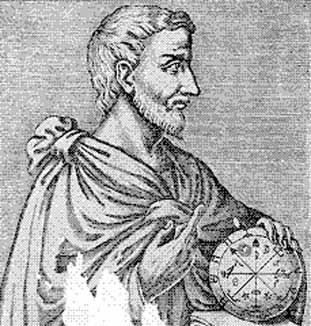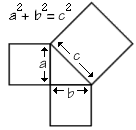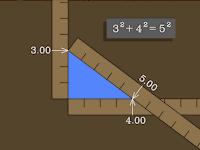PYTHAGORAS AND GEOMETRY

Pythagoras was not only the leader of a
new religion, but also the leader of a academy or lodge for perfect geometry, in
which he expounded the secret of that art.
The astonishing theorem of
Pythagoras, which can be considered as one of the fundaments of freemasonry, is
seen by many masons as his own invention. (constitutions 1738) Plutarchus
however mentions this theorem as one of the essentials from Egyptian religion.
In a ancient english ritual from 1730 we can find:
Q: Why was you made a mason?
A:
For the sake of the letter G. Q: What does it signify?
A: Geometry Q:
Why geometry?
A: because it is the root and foundation of all arts and
sciences.
During the entire Middle
Ages one can see a red thread through religious philosophical thinking. The
knowledge of geometry is maintained since the Greek philosophers throughout the
Middle ages by (amongst others): Augustinus (354-450). It was a attempt to
bring the knowledge of the Greek philosophers together with the basic
assumptions of Christianity.The church father Augustinus was declared holy,
and the scholars of that time were referring to his writings and labors on
geometry, in reasonable safety for prosecution. The authors of the Middle
Ages refer too the Holy church father! In his Trinitatae Augustines puts already
into retrospective the decisions made in Nicea (325), where the antithesis
Father-Son is elevated into a dogma. (Only in 365 the Holy Spirit is inserted as
third); Plato puts his antithesis Spirit-Matter in his Trimaios and resembles
that with Father-Mother, while the son is seen as synthesis. So, you can find
in the eleventh century a elaborate neo-Platonic-Christian literature, in which
the School of Chartres plays a leading role. And until deep in the twelfth
century Augustinus and Boethius are viewed to be the most important literature
on geometry. Since the eleventh century an other line of Platonic thinking is
coming up. In Spain, in Cordoba, the Islamic University also starts teaching in
Latin. And then, in about 990 the School of Chartres is created by bishop
Fulbertus, who was a pupil of Gerbert, who wrote a book on geometry and became
Pope Sylvester II in 999.
What exactly is Geometry?
In the
lectures of Plato we can see geometry at a large scale , although the exact
word geometry is not mentioned. the Timaios is actually completely based on
geometric thinking. Plato tells us in his preamble, that his knowledge can be
traced back to Solon, who supposedly had this knowledge from old Egypt. But
Plato was a bit wrong here. Pythagoras did that; he has been traveling through
Egypt in his day. Through the books of Augustinus and also from Boethius this
knowledge penetrated into the Middle Ages, at which also Gerbert d'Aurillac. the
later Pope Sylvester II played a important part. He wrote a book called 'de
Geometria' in about 990, with knowledge he had found largely in Spain,
Cordoba. Geometry is the knowledge of the structure of heaven and
earth, expressed in number, measure and proportion. The
philosophers from
the Ancient- and the Middle Ages had by far not the knowledge of details of our
scientists today, but they had a deeper general understanding in what we could
call the backgrounds, whom were present in many different sciences . And this
understanding, they gave through from generation to generation with the aid of a
symbolism, in which geometric thinking was the basic middle point. In the
ancient days it was the Pythagorism or the teachings of the Pythagoreans, put
onto paper for the first time by Plato, whose Timaios influenced the
philosophers
from the Middle ages and through them the cathedral builders. And that dear
Sisters and Brethren, is still to be seen in our (free)masonry of today.
back to top | ![]()








